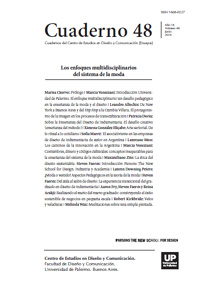Meditation on a simple stitch
Resumo
Hoje, numa escola de arte e design, os estudantes se encontram física e criativamente comprometidos pela demanda no uso de múltiplas dispositivos que desafiam
suas mentes e corpos fazendo da aprendizagem um debate constante entre o intelecto
–conhecimento e o instinto– prática. Na maioria dos casos, os estudantes retiram-se da
oportunidade de aprender e desenvolver-se numa metodologia que lhes permita uma
profunda vinculação com seu ofício. Este artigo tem como objetivo conscientizar sobre a importância de construir a inteligência
táctil, sensorial e criativa através da simples prática e o uso de trabalho manual na produção
de objetos. Através de exemplos de estudantes de design de chapéus, intenta-se demonstrar
que esta prática conduz em última instancia a um maior nível de reconhecimento do
artesanato que se expressa não somente no trabalho senão nos múltiplos aspectos da
vida pessoal. Além, este trabalho defende o cultivo renovado da competência manual
em equilíbrio com as tecnologias digitais como ponte entre os métodos nos quais se
combinam as mãos e a mente num solo esforço / exercício com resultados imediatos
frente aos métodos que requerem tempo e paciência, e que resultam numa experiência
de aprendizagem com múltiplas facetas e para sempre. Meditar sobre um simples ponto
tem um poder que transcende o ato de fazer e construir para se converter numa parte
fundamental da vida como uma pessoa criativa.
Referências
Albers, A. (2000). Anni Albers: Selected writings on design. Hanover, NH: Wesleyan Univer- sity Press.
Andrews, K. (2011, June 18). Meditative quality of simple stitches. [Web log comment].
Retrieved from http://www.theunbrokenthread.com/blog/2011/06/18 Andrews, K. Überlegen - To think, consider, ponder, deliberate. [Web log comment]. Re- trieved from http://www.theunbrokenthread.com/blog/ Anaxagoras (Soulcraft/pg161) Cerf, B. (1956) The Life of the Party: A new collection of stories and anecdotes. Garden City, NY: Doubleday.
Crawford, M. B. (2009). Shop Class as Soulcraft: An inquiry into the value of work. New York: Penguin Group.
Freedman, S. G. (1985, April 21). The Gritty Eloquence of David Mamet. The New York Ti- mes. Section 6, Page 32, Column 2. Retrieved from http://www.nytimes.com/1985/04/21/magazine/the-gritty-eloquence-of-david-mamet.html Greer, B. (2011) Knitting for Good!: A guide to creating personal, social and political change, stitch by stitch. [Web log comment]. Retrieved from http://www.dailyom.com/library/000/001/000001766.html Harris, B. (2002, November 18). Slaves of the Needle: The seamstress in the 1840s. [Web log comment]. Retrieved from http://www.scholars.nus.edu.sg/victorian/gender/ugore tz1.html McCullough, M. (2010). Abstracting Craft: The Practiced Digital Hand. In Adamson, Glenn (Ed.), The Craft Reader (pp. 310-316). Oxford and New York: Berg.
Parker, R. (2011). The Subversive Stitch: Embroidery and the making of the feminine. London and New York: I. B. Taurus & Co Ltd.
Pirsig, R. M. (1974). Zen and the Art of Motorcycle Maintenance: An inquiry into values. New York: HarperTorch An Imprint of HarperCollinsPublisher.
Phillips, M. & Toner-Edgar, M. (2004). Education and Hybrid Practice: Reflective Craft Practice. [Presentation]. Paper presented at the Challenging Craft International Conference, Gray’s School of Art, Aberdeen, Scotland.
Ripley, A. (2012, October 29). Higher Education: College is dead. Long live college! Time, 38-41.
Roudane, M. C. (1984, December 4). An Interview with David Mamet. Retrieved from ht tp://www.upstartfilmcollective.com/portfolios/jcharnick/mamet-museum/old-interview.html Stowe, D. (2006, October 16). A Brief Case for the Useful Arts. [Web log comment]. Retrie- ved from http://wisdomofhands.blogspot.com/2006_10_01_archive.html Toner-Edgar, M.(2012). Thinking Caps. Cumbria, UK: 2QT Limited.
Los autores/as que publiquen en esta revista ceden los derechos de autor y de publicación a "Cuadernos del Centro de Estudios de Diseño y Comunicación", Aceptando el registro de su trabajo bajo una licencia de atribución de Creative Commons, que permite a terceros utilizar lo publicado siempre que de el crédito pertinente a los autores y a esta revista.


